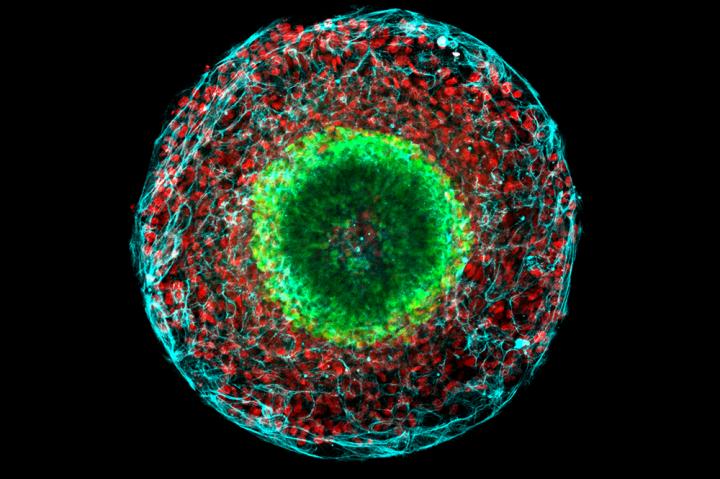Study gives clues to the origin of Huntington's disease, and a new way to find drugs

Developmental diseases can now be studied with new technology involving tiny brain models called neuruloids, shown here. Credit: Laboratory of Stem Cell Biology and Molecular Embryology at The Rockefeller University Usage Restrictions: Image may only be used to illustrate research described in the accompanying release.
Developed in the lab of Ali Brivanlou, the Robert and Harriet Heilbrunn Professor, the system uses neuroloids–tiny, three-dimensional tissue cultures that serve as models for whole organs.
The researchers create these cell clumps from human embryonic stem cells and manipulate them in the lab to study how developmental diseases arise.
Previous work in the Brivanlou lab found evidence that the disease arises in young neurons; but this latest study takes the developmental timeframe back even further, to the step in the brain's development when cellular uniformity gives way to the emergence of particular structures, a process called neurulation.
When the researchers introduced into neuroloids a mutation known to cause Huntington's, it consistently caused dramatic effects with abnormally shaped tissue structures. “Something's collapsed,” Brivanlou says.
The researchers have started using the technology to screen for drugs that prevent these abnormalities, an approach they hope will provide a powerful alternative to similar work being done in animal models.
“This technology really opens a door toward identifying that mechanisms that govern brain development, understanding how they go awry in disease, and testing drugs that set these mechanisms back on the right course,” says Brivanlou.
Media Contact
All latest news from the category: Life Sciences and Chemistry
Articles and reports from the Life Sciences and chemistry area deal with applied and basic research into modern biology, chemistry and human medicine.
Valuable information can be found on a range of life sciences fields including bacteriology, biochemistry, bionics, bioinformatics, biophysics, biotechnology, genetics, geobotany, human biology, marine biology, microbiology, molecular biology, cellular biology, zoology, bioinorganic chemistry, microchemistry and environmental chemistry.
Newest articles

Superradiant atoms could push the boundaries of how precisely time can be measured
Superradiant atoms can help us measure time more precisely than ever. In a new study, researchers from the University of Copenhagen present a new method for measuring the time interval,…

Ion thermoelectric conversion devices for near room temperature
The electrode sheet of the thermoelectric device consists of ionic hydrogel, which is sandwiched between the electrodes to form, and the Prussian blue on the electrode undergoes a redox reaction…

Zap Energy achieves 37-million-degree temperatures in a compact device
New publication reports record electron temperatures for a small-scale, sheared-flow-stabilized Z-pinch fusion device. In the nine decades since humans first produced fusion reactions, only a few fusion technologies have demonstrated…





















